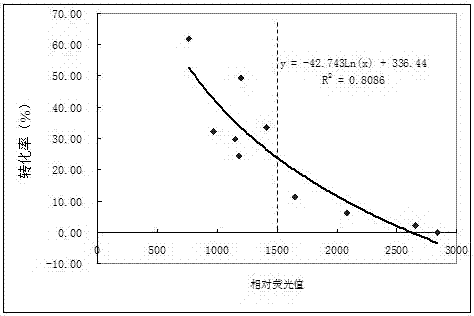Method for appraising quality of plant callus
A callus and quality identification technology, applied in the field of plant tissue culture, can solve problems such as inability to distinguish callus, and achieve the effects of accurate judgment and simple operation.
- Summary
- Abstract
- Description
- Claims
- Application Information
AI Technical Summary
Problems solved by technology
Method used
Image
Examples
Embodiment 1
[0017] Example 1 Analysis of Transgenic Efficiency Using Relative Fluorescence Values
[0018] 1.1 Material description
[0019] 10 kinds of calli were selected for the transgenic experiment: ZH11-1, ZH11-2, 9311-1, 9311-2, 9311-3, Njx74-1, Njx74-2, YTA-1, YTA-2, YTA-3 . Among them, ZH11-1, 9311-1, Njx74-1, and YTA-1 are calli induced and subcultured on LY medium, and ZH11-2, 9311-3, and YTA-3 are induced and subcultured on N6 medium. Subcultured calli, 9311-2, Njx74-2, YTA-2 are calli induced on LY medium but subcultured on N6 medium. Among them, LY medium was purchased from Wuhan Luoying Biotechnology Co., Ltd. (LY medium kit includes LY medium, LY-A reagent, LY-B reagent, etc.).
[0020] Transgenic strain: EHA105
[0021] Transgenic plasmid: pCAMBIA1301
[0022] Fluorescence detection: Take 0.5g of various calli and add them to 2ml of 1M NaCl solution, grind until homogenized, centrifuge at 14,000g for 5min, resuspend the supernatant and precipitate with 60% (W / V) su...
Embodiment 2
[0100] Example 2 Using Relative Fluorescence Values to Analyze Changes in Callus Quality During Culture
[0101] Materials and methods
[0102] Experimental materials: japonica rice material Zhonghua 11 (ZH11), indica rice material Nanjing Xian 74 (NJX74).
[0103] experimental method:
[0104] Induction: Induction and subculture were carried out on LY medium (purchased from Wuhan Luoying Biotechnology Co., Ltd.) to obtain embryogenic callus. Induction method, first remove the glumes of mature embryos, then soak in 75% ethanol for 1 min, 0.75% mercuric chloride aqueous solution for 15 min, wash 5-6 times with sterile water, and inoculate on the induction medium. The induction medium is LY medium supplemented with 0.5g / L glutamine, 0.8g / L acid hydrolyzed casein, 30g / L sucrose, 2.5g / L phytogel, and 100μl / L LY-A; to induce growth Conditions: Induction at 33 °C. Starting from the 10th day, samples were taken and analyzed on the tenth, fourteenth, seventeenth and twen...
Embodiment 3
[0110] Example 3 Analyzing the Effects of Different Mediums with Relative Fluorescence Values
[0111] Materials and methods
[0112] One japonica variety ZH11 was selected. Four indica varieties MH63, YTB, NJX74, 9311 were selected.
[0113] ZH11-L, MH63-L, YTB-L, NJX74-L, 9311-L are the corresponding varieties of calli induced and subcultured on LY medium. ZH11-N, MH63-N, YTB-N, NJX74-N, 9311-N were induced and subcultured on N6 medium for the corresponding varieties of calli. The culture condition was 30°C, and samples were taken for analysis 12 days after induction for 30 days. Analysis method is with embodiment 1.
[0114] result
[0115] Table 2 The culture results of LY medium and N6 medium on callus of different varieties
[0116] MH63-L MH63-N YTB-L YTB-N NJX74-L NJX74-N ZH11-L ZH11-N 9311-L 9311-N RUF-1 a 1767.84 2624.26 905.58 1792.5 1458.64 1754.49 875.394 775.494 1355.69 3341.35 RUF-2 a 1784.96 2560...
PUM
| Property | Measurement | Unit |
|---|---|---|
| wavelength | aaaaa | aaaaa |
Abstract
Description
Claims
Application Information
 Login to View More
Login to View More - R&D
- Intellectual Property
- Life Sciences
- Materials
- Tech Scout
- Unparalleled Data Quality
- Higher Quality Content
- 60% Fewer Hallucinations
Browse by: Latest US Patents, China's latest patents, Technical Efficacy Thesaurus, Application Domain, Technology Topic, Popular Technical Reports.
© 2025 PatSnap. All rights reserved.Legal|Privacy policy|Modern Slavery Act Transparency Statement|Sitemap|About US| Contact US: help@patsnap.com



